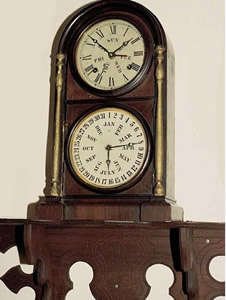The Welch, Spring & Company was organized by three clock enthusiasts— Elisha Niles Welch, Solomon Crosby Spring, and Benjamin Bennet Lewis. Their partnership lasted for sixteen years, from 1868 to 1884.
Each of these men brought a talent that contributed to the success of the organization. Welch was the financier, Spring was the manager and design engineer, and Lewis was the inventor. These men were interested in developing a superior clock line, in contrast to most other American clock companies at the time, which sought quantity rather than quality.
Welch, Spring & Co. rosewood calendar clock w/B. B. Lewis’ perpetual movement, patented Dec. i8>
1868, eight-davtime & strike, 11 x 20″ h. $1,050.
At 22, Welch formed a partnership with Thomas Barnes using a Barnes and Welch label as the company’s logo. On two separate occasions, in 1841 and again in 1880, Welch loaned money to J. C. Brown, a fellow clockmaker. When Brown’s company became insolvent, Welch purchased it from him and bought two other Bristol firms— The Forestville Hardware and Clock Company and The Frederick Otis Case Shop. He consolidated these clock holdings under the name of E. N. Welch Manufacturing Company. Because he was a wise and cautious investor, he was consistently successful in business. In fact, it was largely due to Welch’s support that the Welch, Spring & Co. succeeded.
Lewis’ contribution to the new company was his ability to develop calendar mechanisms. He received three patents for perpetual-calendar mechanisms, dated 1862,1864, and 1868.
The remaining member of the company, Spring, was a renowned casemaker who specialized in rosewTood cases. He learned basic techniques while working for the Atkins Clock Company. After leaving this company, he spent about twenty years operating his own business. After purchasing the defunct Birge, Peck & Company, he named it the S. C. Spring Clock Company. The newly reorganized company supplied cases, movements, and parts to clockmakers in the Bristol, Connecticut, area. He also manufactured vast numbers of clocks for the parent company.
Welch, Spring & Company passed through four stages during its sixteen years. The first stage, from 1868 to 1869, was devoted to creating a standard shelf model. The company produced three models—the Empress, the Peerless, and the Italian.
During the second stage, lasting from 1870 to 1876, emphasis was on the production of regulators and calendar clocks. Only five styles of regulators and five styles of calendars were made. All of the calendar clocks used the B. B. Lewis perpetual-calendar mechanism and could be purchased with walnut or rosewood cases. The majority of the No. l regulators were made with rosewood cases. The walnut case, at $95, was too expensive for the average American, so few were produced in this model.
In the third stage, from 1877 to 1888, the company focused on selecting clock names that were familiar to the public and that implied quality. Other manufacturers were naming their clocks after regents, cities, and rivers, so Spring and other staff members decided to name their series after popular opera and theater stars of the day. The 1877 Spring models included the names of seven composers and opera singers—Parepa, Lucca, Titiens, Verdi, Kellogg, Auber, and Wagner.
The names were used for a variety of clock styles, including shelf clocks, regulators, octagons, and calendar clocks. The two shelf clocks available in rosewood were the Parepa and the Lucca. The latter was also made as a regulator, and the Titiens, a shelf clock, was made with a walnut case. The octagon clock was dubbed the Verdi, and the wall regulator in walnut was named the Kellogg. The other two—the Auber, a shelf calendar clock, and the Wagner, in both wall and shelf calendar versions-had black walnut cases.
The fourth and final stage, called the Patti Era, lasted for five years, from 1879 to 1884. This developmental period was named for Adelina Patti (1843-1919), a Spanish coloratura soprano who won fame as one of the world’s greatest operatic singers. Her career was almost without parallel in the history of opera.
This period marked the company’s final effort to be financially successful. The staff believed the company’s success would depend on the success of the Patti model. The original Patti clock was known for its fancy column turnings, glass sides, rosettes, and fancy finials. Its case was rosewood and featured a Sandwich glass pendulum. The Patti was considered by many as the most collectible and famous parlor clock ever conceived by an American manufacturer. However, sales did not live up to expectations.
The company tried to dress up the Patti to improve its sales. It added French-style cloverleaf hands, a brass pendulum with a Sandwich glass center, a gold leaf border on the glass door panel, and a bell mounted on the movement. Black labels with gold print replaced the white labels with black print.
These changes, however, did not solve the company’s problem. The Welch, Spring, & Company failed because the clocks were too costly to produce and too expensive for the public to buy. In 1884, the company ceased doing business. E. N. Welch purchased all the buildings, inventor}’, and machinery of the Welch, Spring & Company for $10,000. Mass production had won, and the ornate “Patti” clocks failed to appeal to the average citizen because of their high cost. Despite this, E. N. Welch died a wealthy man in 1887, leaving an estate of approximately three million dollars.

